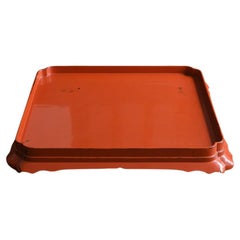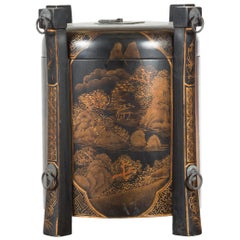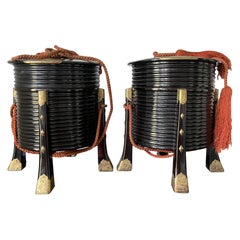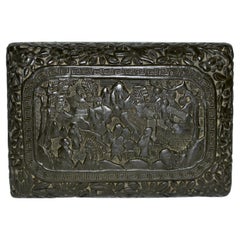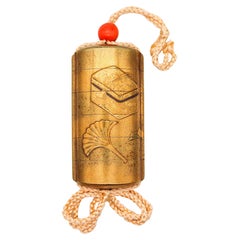East Asian Lacquer
to
40
313
123
483
5
2
4
2
78
264
141
7
78
31
9
7
1
11
6
1
3
3
382
211
103
40
32
557
490
289
196
42
490
486
489
3
1
1
1
1
Place of Origin: East Asian
A large square tray made of Japanese antique lacquer / Late Edo period/19th
Located in Sammu-shi, Chiba
These trays were made after the late Edo period in Japan (after 1800).
This particular type of tray is known as "Negoro-bon."
Negoro lacquerware is a specific style of Japanese lacqu...
Category
19th Century Edo Antique East Asian Lacquer
Materials
Lacquer
Chinese Vintage Black Lacquer Game Box with Gilded Traditional Landscape Scenes
Located in Yonkers, NY
A Chinese vintage lacquer game box from the mid 20th century, with gold leaf hand-painted landscape and floral décor. Created in China during the midcentury period, this vintage game box features a black lacquer ground perfectly accented with gilded hand-painted traditional landscapes and pagodas. The circular body, flanked with straight splaying supports, is topped with a lid revealing the small storage space. With its elegant lines and complimenting colors, this vintage Chinese game box...
Category
Mid-20th Century East Asian Lacquer
Materials
Wood
Pair of Large Antique Japanese Hokai Lacquer Boxes
Located in Atlanta, GA
A pair of Japanese lacquered lidded Hokai boxes with chased brass hardware and original ropes. Hokai boxes are traditionally used in Japan as the containers ...
Category
Early 20th Century Japonisme East Asian Lacquer
Materials
Wood, Lacquer
Antique Black Lacquered Carved Box Village Life
Located in Somis, CA
This captivating early 20th-century lacquerware box transports you to a serene Chinese farming village. The fully carved lid unfolds a scene of daily life: two men, one seated on a ...
Category
Early 20th Century Qing East Asian Lacquer
Materials
Kork, Wood, Lacquer
$95 Sale Price
38% Off
Japan 1800 Edo Period Six Drawer Inro In Lacquered Gilt Wood With Utensils
Located in Miami, FL
Japanese Inro from the Edo Period (1603-1867).
Beautiful Inro, created in Japan during the Edo period (Shogunate), circa 1800. It was carefully crafted in carved precious wood with ...
Category
Early 1800s Edo Antique East Asian Lacquer
Materials
Coral
$2,600 Sale Price
20% Off
Japanese Maki-e Lacquer Document Box, Edo Period, early 19th Century, Japan
Located in Austin, TX
A spectacular Japanese maki-e lacquer lidded box, possibly a writing box, suzuribako, decorated with images of folding fans, ogi, Edo Period, earl...
Category
Early 19th Century Edo Antique East Asian Lacquer
Materials
Coral
19th Century Chinese Lacquered and Giltwood Frame Fan
Located in Brea, CA
19th century Chinese lacquered and giltwood frame fan with chinoiserie decoration double leaf depicting Chinese daily scenes, animals and flowers with origi...
Category
Early 19th Century Qing Antique East Asian Lacquer
Materials
Lacquer
18th Century Gilt Black Chinese Larquer Cabinet Desk
Located in Brea, CA
18th century gilt black lacquer Chinese cabinet desk, the rectangular-section body decorated with panels of landscapes, the superstructure of two panelled doors, enclosing an array o...
Category
Early 18th Century Qing Antique East Asian Lacquer
Materials
Lacquer
19th Century Chinese Export Black Lacquer & Mother Of Pearl Sewing Box
Located in Atlanta, GA
This stunning 19th-century Chinese Export sewing box showcases exceptional craftsmanship and intricate decorative artistry. The rectangular box features a black lacquered surface ado...
Category
19th Century Chinese Export Antique East Asian Lacquer
Materials
Wood, Lacquer
$1,440 Sale Price
20% Off
Japanese Lacquer Incense Box, Kogo, Momoyama or Edo Period, 16th/17th Century
Located in Austin, TX
A wonderful Japanese lacquer incense box, kogo, with a design of plovers in flight, late Momoyama or early Edo Period, circa 1600, Japan.
The small box, called a kogo, was used to s...
Category
Early 17th Century Edo Antique East Asian Lacquer
Materials
Gold, Pewter
Antique Japanese Lacquer and Inlay Box from Ryukyu Island
Located in Atlanta, GA
A lacquer presentation box with mother-of-pearl inlays from Japanese Ryukyu Islands circa 17-18th century. The lidded box in rectangular form with rounded corner is a classic example...
Category
18th Century Japonisme Antique East Asian Lacquer
Materials
Mother-of-Pearl, Lacquer
Antique Japanese Edo Makie Lacquered Stand Hibachi Brazier Tea Fire Bowl Brass
Located in Dayton, OH
Antique Japanese late Edo / Tokugawa period Hibachi used for burning coal, as a portable heater, and as a heating device for a pot of tea. In modern times they work well as a planter...
Category
19th Century Edo Antique East Asian Lacquer
Materials
Brass
$800 Sale Price
20% Off
Japanese Maki-e Lacquer Stacking Box, Jubako, Meiji Period, Japan
Located in Austin, TX
A fine and impressive Japanese gold maki-e decorated black lacquer five-tier jubako with presentation tray, two lids, and the original tomobako storage box, Meiji period, late 19th c...
Category
Late 19th Century Meiji Antique East Asian Lacquer
Materials
Lacquer
Japanese Antique Lacquer Hair Comb with Flowers in Gold Maki-e
Located in New York, NY
Stunning antique Japanese lacquer hair comb with a geometric petal-like background of stylized chrysanthemums and flowers done in gold and red maki-e. Possibly Edo or Meiji time peri...
Category
Mid-19th Century Antique East Asian Lacquer
Materials
Giltwood, Lacquer
Japanese Rinpa Style Lacquer Ink Stone Box Suzuribako
Located in Atlanta, GA
A Japanese writing box with ink stone (known as Suzuribako) with exquisite maki-e decoration circa late Meiji to early Taisho period (1890s-1930s)...
Category
Early 20th Century Japonisme East Asian Lacquer
Materials
Wood, Lacquer
Chinese Soapstone, Semiprecious Hardstone and Lacquer Folding Screen
Located in Miami, FL
This stunning Chinese screen is an exceptionally well-crafted piece, beautifully decorated with intricate semiprecious hardstone carvings. Measuring ...
Category
Mid-20th Century Chinese Export East Asian Lacquer
Materials
Precious Stone, Wood
Japanese Lacquer and Cinnabar "Samurai" Cabinet, Inaba Family, Edo Period
Located in Troy, NY
Exceptionally large and rare lacquer cabinet. According to the heraldry, visible on the headgear in one of the panels, it was made for the Inaba family, a high ranking Daimyo family,...
Category
Late 19th Century Edo Antique East Asian Lacquer
Materials
Wood
Exquisite Japanese Lacquer Maki-e Suzuribako by Koma Kyūhaku Edo Period
Located in Atlanta, GA
One of the finest Japanese Maki-e Suzuribakos (ink box) we have on offer, the roiro color box showcases an ambient nocturnal scene in which two shakudo inlaid crows perched on the handrails of a bridge (possible the Uji Bridge...
Category
Early 19th Century Japonisme Antique East Asian Lacquer
Materials
Stone, Metal
Antique 19th Century Chinese Lacquer Sewing Box with the Stand
Located in Brea, CA
Antique 19th century Chinese lacquer sewing table with hand painted scenes and beautiful legs. Gilt export black lacquer all-over the tabl...
Category
Late 19th Century Qing Antique East Asian Lacquer
Materials
Lacquer
Japanese Lacquer Meiji Period Cabinet on Stand, circa 1890
Located in Brighton, Sussex
A exquisite, fine quality Meiji period (1868-1912) Japanese black lacquer cabinet on stand with wonderful scrolling gilded decoration. H...
Category
Late 19th Century Japonisme Antique East Asian Lacquer
Materials
Lacquer
17th Century Japanese Export Lacquer Cabinet with Depiction the Dutch Tradepost
Located in Amsterdam, NL
A highly important Japanese export lacquer cabinet with depiction of the Dutch East India Company tradepost Deshima and the annual Dutch delegation on its way to the Shogun in Edo
Edo period, circa 1660-1680
H. 88 x W. 100.5 x D. 54 cm
This cabinet includes a later European japanned stand, but also a modern powder-coated steel frame.
The latter can be designed and added to your specific needs.
The sides and front of the rectangular two-door cabinet are embellished in gold and silver hiramaki-e and takamaki-e on a black roiro lacquer ground with a continuous design. The two doors depict a long procession of numerous figures travelling on foot and horseback along buildings and a pagoda into a mountainous landscape. This is the annual court journey, Hofreis, of the Dutch from Nagasaki to the Shogun’s court in Edo. Three horseback riders are dressed as Dutch merchants and a fourth figure, probably het Opperhoofd, is seen inside a palanquin, norimon. Just about to cross the bridge, two men are carrying a cabinet like the present one.
Many Japanese figures on either side of the procession are engaged in various activities; some play musical instruments on board of small boats, others are fishing; figures inside buildings are depicted playing go, and farmers are tending to their rice paddocks. The upper part of the right door shows a large mansion, probably the local daimyo’s castle, with men kneeling before a man in the central courtyard.
The court journey fits in with the foreign policy of the shogunate which accorded a role to the VOC alongside China, Korea, and the Ryukyu Islands who also had to pay tribute. However, the VOC employees were traders, having low status in Japan’s social hierarchy, and they were received with less deference than were the state embassies from Korea and the Ryukyu Islands. Nevertheless, the contacts with the Dutch were a welcome source of information to the Shogun about Europe and European science and technology.
The left side of the cabinet depicts, in mirror image, a rare view of the artificial fan-shaped Deshima Island, the trading post for the Dutch in Japan. The island, where the Dutch flag flies, is surrounded by small Japanese boats and an anchored three-masted fluyt (cargo ship), flying Dutch flags, with on the stern the VOC monogram. On the bottom right a busy street of Nagasaki is shown, bordered by shops and leading up to the stone bridge. On the island the trees are beautifully painted, two cows can be seen, and the flagpole, all in very fine detail. Dutchmen and enslaved Malay are visible outside the buildings and two Japanese figures, probably guards, sit in a small hut in the centre.
A maximum of fifteen to twenty Dutchmen lived on the island at any time and soldiers or women were not allowed. Restrictions on Deshima were tight, and the merchants were only allowed to leave the island by special permission. The Opperhoofd had to be replaced every year, and each new Opperhoofd had to make a court journey to pay tribute, present gifts, and to obtain permission to Margaret Barclay eep on trading. In the distance, many birds fly above the hills and a four-story pagoda can be seen. The right side of the cabinet is painted with other horse riders and their retinue journeying through mountains.
The pair of doors to the front open to reveal ten rectangular drawers. The drawers are decorated with scenes of birds in flight and landscapes with trees and plants. The reverse of the left door with two thatched buildings, one with a ladder, underneath a camelia tree with large blooms; the right door with a three-story pagoda nestled among trees and both doors with a flying phoenix, ho-oo bird. The cabinet, with elaborately engraved gilt copper mounts, hinges, lock plates and brass handles, is raised on an 18th-century English japanned wood stand.
A pair of large cabinets...
Category
17th Century Edo Antique East Asian Lacquer
Materials
Copper, Gold
Antique Chinese Smith Armorial Games Box and Counters
Located in Bishop's Stortford, Hertfordshire
A stunning and rare antique Chinese armorial games box of rectangular form with over 110 matching armorial mother of pearl gaming counters. The black lacquer box is finely decorated with a central Chinese landscape scene, the centre with an armorial for Smith impaling Abbot. The box opens to reveal five lidded boxes each with similar decoration to that on the box outer and each with a central armorial crest. The box also contains 12 gaming trays, four of which are decorated with the same armorial as is the addition of the Pope Joan...
Category
Early 19th Century Antique East Asian Lacquer
Materials
Lacquer
Pair of Chinese Carved and Lacquered Door Panels
Located in Queens, NY
Pair of Asian Chinese style (19th Century) red lacquered carved filigree door panels with scenes (PRICED AS Pair).
Category
19th Century Antique East Asian Lacquer
Materials
Wood
$18,000 / set
Japanese inro box in black and gold lacquer with a decor of snowy landscape
Located in PARIS, FR
Inrō with four boxes in black and gold lacquer, representing a person in a pavilion in a snowy landscape with mountain on the background. Realised in maki-e on black lacquer with sma...
Category
Late 18th Century Edo Antique East Asian Lacquer
Materials
Gold
Antique 19th Century Chinese Lacquer Sewing Box with the Stand
Located in Brea, CA
Antique 19th century Chinese lacquer sewing table with hand painted scenes and beautiful legs. Gilt export black lacquer all-over the table.
Category
Mid-19th Century Qing Antique East Asian Lacquer
Materials
Lacquer
19th Century Large Chinese Lacquer Wedding or Travel Box
Located in Brea, CA
19th century large Chinese lacquer wedding or travel box from the Qing dynasty. Beautiful intricate designs all-over with images of ancient Chi...
Category
19th Century Qing Antique East Asian Lacquer
Materials
Lacquer
Japan 1870 Meiji Period Round Five Drawer Inro Lacquered Wood With Flying Cranes
Located in Miami, FL
Japanese Inro from the Meiji Period (1868-1912).
Beautiful Inro, created in Japan during the Meiji imperial period, circa 1870. It was carefully crafted in carved precious wood with applications of lacquer and decorated with orientalism patterns. All dan trays are attached together with a himo cord. The detailed craftsmanship was a true pleasure to behold.
Period: Meiji 1868-1912, Period of Emperor Mutsuhito.
Approximate Date: 1870.
Motif: Organic design with cascade landscape scene and five flying cranes.
Drawers: Five.
Shape: Cylinder. Very unusual and rare shape.
Technique: Carved wood, Lacquer, hiramaki-e, takamaki-e, Gilding.
Ojime: 17mm, round with Ebony wood.
Netsuke: Carved dressed...
Category
1870s Meiji Antique East Asian Lacquer
Materials
Wood, Ebony, Giltwood, Lacquer
$2,388 Sale Price
20% Off
Chinese Coromandel Lacquer Eight Fold Screen, Early 20th Century
Located in Brighton, Sussex
A very good quality early 20th century Chinese Coromandel lacquer eight fold screen. Depicting a classical Pagoda buildings with numerous courtiers wondering around. Bordered with fa...
Category
Early 20th Century East Asian Lacquer
Materials
Lacquer
18th Century Pair of Chinese Silver Lacquer Bowls with Mother of Pearl Inlaid
Located in Brea, CA
Pair of Chinese silver, lacquer, and mother of pearl big bowls from the 18th century. The faces each of a thin sheet of distressed silver over a body of black lacquered wood with mot...
Category
18th Century Qing Antique East Asian Lacquer
Materials
Lacquer
Pair of Chinese Chippendale Qing Dynasty Red Lacquered King Wood Arm Chairs 1840
Located in Charleston, SC
Pair of Chinese Chippendale Qing Dynasty red lacquered king wood serpentine crest curvature arm chairs with decorative carved straight legs and original connecting stretchers. Mid 19...
Category
1780s Chinese Chippendale Antique East Asian Lacquer
Materials
Kingwood, Lacquer
Large 19th Century Chinese Red Lacquered Palace Vases on Stands
Located in Palm Springs, CA
A pair of monumental red lacquered Chinese palace vases on stands. These are crafted out of wood and paper mache. There are many motifs around thes...
Category
19th Century Antique East Asian Lacquer
Materials
Lacquer
Mother-of-Pearl Black Lacquer Japanese Export Table with Feet Shaped as Bats
Located in Amsterdam, NL
A Japanese export lacquer tripod table with feet shaped as bats
Nagasaki, 1850-1860
H. 73 x diam. 108 cm
The six-lobbed top is decorated with reverse-painted mother-of-pearl in a sprawling motif of plum blossom, bamboo, and peonies, surrounded by fluttering sparrows enhanced by details in maki-e.
The table, made to appeal to a foreign audience, incorporates a curious mixture of seasonal references. In addition to the decoration of foliage from late winter and spring, the column is decorated with grapes and a rabbit pounding rice, both Japanese motifs for autumn and the month of September. The feet, shaped like bats that almost appear to wake up from hibernation, symbolise luck and happiness in Japan.
The present flamboyant Nagasaki-style table is depicted in the Asada workshop drawings of 1856. These drawings, titled Aogai makie hiinagata hikae (memorandum of designs for lacquer with inlaid pearl...
Category
19th Century Antique East Asian Lacquer
Materials
Lacquer
19th Century a Pair of Chinese Fan with Frame Box
Located in Brea, CA
Antique 19th century a pair of silk Chinese fans, Qing dynasty with fan frame box. Fan is 18inch x 10'' x 2''.
Category
1850s Qing Antique East Asian Lacquer
Materials
Silk
Korean Lacquer and Mother of Pearl Inlay "Longevity" Box, 1930s, Korea
Located in Austin, TX
A fine and elegant Korean black lacquer and abalone mother of pearl inlay "longevity" box, circa 1930s, Korea.
The box, most likely used to sto...
Category
1930s Showa Vintage East Asian Lacquer
Materials
Wood, Lacquer, Abalone
Rare Charming 17th Century Japanese Lacquer Cabinet with Gilt-Bronze Mounts
Located in Amsterdam, NL
A fine Japanese pictoral style lacquer cabinet with gilt-metal mounts
Kyoto, Edo period, 1670-1690
Decorated in Japanese relief lacquer work, black lacquer ground decorated...
Category
Late 17th Century Antique East Asian Lacquer
Materials
Bronze
$44,304 Sale Price
25% Off
Antique Chinese Cinnabar, Brass and Enamel Box
Located in Miami, FL
A crisply carved antique Chinese red cinnabar lacquer lidded round box with blue enamel interior and brass fittings. The "dragon's blood" trinket box has a fine peony, foliate and fl...
Category
19th Century Qing Antique East Asian Lacquer
Materials
Brass, Enamel
Beautiful Japanese Lacquered Tray Raden Abalone Shell Decoration
Located in Fukuoka, JP
Beautiful Japanese Lacquered Tray with Raden Abalone Shell Decoration
This beautiful Japanese lacquered tray is a stunning example of Japanese craftsmanship. It is made of high-quality wood and is decorated with abalone shell inlay, a technique known as raden. Raden is a centuries-old Japanese art form that involves inlaying mother-of-pearl, abalone shell, or other materials into a lacquer surface. The technique originated in China and was introduced to Japan in the Nara period...
Category
20th Century East Asian Lacquer
Materials
Lacquer
18th Century Pair of Chinese Silver Lacquer Bowls with Mother of Pearl Inlaid
Located in Brea, CA
Pair of Chinese silver, lacquer, and mother of pearl burgaute "Bat " bowls, each inlaid in mother of pearl with bats in flight amongst stylized clouds between a band of cash to the r...
Category
18th Century Qing Antique East Asian Lacquer
Materials
Lacquer
Large 20th C. Chinese 6 Panel Lacquered Hardstone and Jade Coromandel Screen
Located in New York, NY
A large 20th century Chinese six panel Lacquered Hardstone and Jade Coromandel screen. This screen features intricately carved hardstone, soapstone, jade, lapis, quartz, and other ha...
Category
20th Century Qing East Asian Lacquer
Materials
Stone, Jade, Lapis Lazuli, Soapstone
Japanese Namban Chest adorned with cylindrical motives and mother of pearl inlay
Located in PARIS, FR
Small namban style chest with a semi-cylindrical lid made of black lacquered wood (urushi) with gold lacquer (maki-e) and inlaid with mother-of-pearl (raden).
Mon style decoration (...
Category
Mid-18th Century Antique East Asian Lacquer
Materials
Lacquer, Mother-of-Pearl
Antique Japanese Ink Stone Maki-e Lacquer Box Suzuribako Edo Provenance
Located in Atlanta, GA
A Japanese ink stone box (known as Suzuribako) with exquisite maki-e decoration from Edo period (circa mid-18th century). The box features a rectang...
Category
18th Century Edo Antique East Asian Lacquer
Materials
Wood, Lacquer
Mid-20th Century Chinese Hand Carved Cinnabar Lacquer Plate
Located in Pomona, CA
This stunning Chinese hand carved cinnabar lacquered plate has Intricate lacquer carving arts of Chinese traditional archetecture and landscape design. It named The Sense of Tough, a...
Category
Mid-20th Century Chinese Export East Asian Lacquer
Materials
Lacquer
Japanese lacquer suzuri’bako 硯箱 (writing box) with shishi & Hotei design
Located in Amsterdam, NL
A captivating lacquer suzuri’bako (writing box) of rounded rectangular form depicting a pair of shishi (temple lions) and the lucky god Hotei 布袋 on a rôiro...
Category
Early 19th Century Antique East Asian Lacquer
Materials
Gold Leaf, Silver Leaf
Japanese 7-Pcs, Arita Sweetmeat Set & Matching Lacquer Box Meiji Period, 1880s
Located in Ottawa, Ontario
A seven-piece Japanese Arita Sweetmeat set and matching lacquer box, Meiji period (1880-1890). Comprising of a central hexagonal dish and six-fan shaped ...
Category
Late 19th Century Meiji Antique East Asian Lacquer
Materials
Porcelain, Lacquer
Japanese Black Lacquer Document Box with Gold Plum Blossom Design, Taisho Period
Located in Prahran, Victoria
A high quality, antique, Japanese black lacquer document box. It has an external design of gold maki e plum blossoms. In Japanese culture plum blossom symbolises the beginning of Spring, having its own festival, the Ume Matsuri, alongside the more famous cherry blossom festival...
Category
1920s Vintage East Asian Lacquer
Materials
Wood, Lacquer
$2,880 Sale Price
20% Off
Antique Japanese Lacquer and Inlay Table from Ryukyu Islands
Located in Atlanta, GA
A small square-form table with lacquer and intricate mother-of-pearl inlay design from Ryukyu Islands kingdom circa 17-18th century. Ryukyuan kingdom was used to be an independent is...
Category
18th Century Edo Antique East Asian Lacquer
Materials
Mother-of-Pearl, Lacquer
Japanese lacquer suzuri’bako 硯箱 (writing box) with ‘Rinpa School’-style design
Located in Amsterdam, NL
Superb rectangular ‘Rinpa School’-style black lacquer suzuri’bako (writing box) with a slightly arched well-fitted overhanging cover with rounded corners.
The lid with a design of a gosho’guruma (ox-drawn carriage for Heian-era nobles) featuring golden hiramaki-e (low-relief lacquer design) and takamaki-e (high-relief lacquer design), inlays of lead and shiny mother-of-pearl (raden). The design continues along the sides.
The reverse of the lid decorated with two large curving pine trees (matsu) executed in the same way, but also with intricate dots of tiny pieces of inlaid blue mother-of-pearl along the golden trunk.
The interior shaped to hold various scholar’s accessories, including a partially gold lacquered inkstone (suzuri) and a bronze waterdropper (suiteki) shaped like a mythical minogame.
The interior inscribed ‘Hokkyô Kôrin zô’ (Made by Hokkyô Kôrin). Referring to the design being in style of the master Ogata Kôrin, but the actual lacquer artist is unknown. It is a homage to Kôrin by an artist that followed the school of Rinpa.
Including black lacquer wooden tomobako (tomobako).
The Rinpa School was a key part of the Edo period revival of indigenous Japanese artistic interests described by the term yamato-e. Paintings, textiles, ceramics, and lacquerwares were decorated by Rinpa artists with vibrant colours applied in a highly decorative and patterned manner. Favoured themes, which often contained evocative references to nature and the seasons, were drawn from Japanese literature, notably The Tale of Genji, The Tales of Ise...
Category
19th Century Antique East Asian Lacquer
Materials
Brass, Lead
Exceptional Chinese Export Gilt Black Lacquer Chinoiserie Decorated Lap Desk
Located in Atlanta, GA
Chinese export, circa 1820.
An exceptional quality and rare form. Featuring figural landscape decorations in gilt to the main black lacquer doors, which open to reveal 13 separated c...
Category
Early 19th Century Chinese Export Antique East Asian Lacquer
Materials
Giltwood, Lacquer
$2,072 Sale Price
20% Off
Superb Late 16th Century Signed Colonial Japanese Namban Export Lacquer Coffer
Located in Amsterdam, NL
Superb late 16th century signed colonial Japanese Namban export lacquer coffer
Momoyama period, late 16th/early 17th century, inscribed 'Arisato' on the bottom
H. 30.5 x W. 43...
Category
16th Century Antique East Asian Lacquer
Materials
Cedar, Lacquer
Pair of Fine Japanese Export Lacquer Cutlery Knife Boxes, 18th Century
Located in Amsterdam, NL
A pair of fine Japanese export lacquered cutlery boxes
Kyoto or Nagasaki, late 18th century
H. 33.5 x W. 24 x D. 21 cm
The bow-fronted boxes with sloping lids flat at the top are made of hinoki wood (Cypress), coated with Japanese paper and decorated in lacquer with scattered gold birds and flowers on a nashiji background. The Japanese mounts are made of copper and both boxes still have internal partitions to keep the cutlery upright.
The form of these boxes is similar to a pictorial-style knife box in the collection of the Groninger Museum (inv. 1989- 347), dated between 1730 and 1780, but the style of the decoration is more like that on a knife box in the Peabody Essex Museum in Salem (inv. E62271), which was brought to Salem by James Devereux, Captain of the Franklin, in 1799.
Provenance:
Henriette Jeane Christine van Neukirchen, called Nyvenheim (1807- 1849) and Nicolaas Johan Steengracht van Oostcapelle (1806-1866), thence by descent to the last owners, Ludolphine Emilie baronesse Schimmelpenninck van der Oye (1944) married in 1969 to Roland Daniel van Haersma Buma (1944), the last residents of castle Duivenvoorden near Voorschoten and the great-great-granddaughter of Nicolaas Johan Steengracht van Oostcapelle.
There is no evidence that Nicolaas Johan himself, or any of his or his wife’s ancestors had ever been in Japan. However, Nicolaas’ grandfather (Nicolaas Steengracht, 1754-1840) was a director of both the VOC and WIC (West Indies Company...
Category
Late 18th Century Antique East Asian Lacquer
Materials
Silver
Chinese Chinoiserie Decorated Lacquer Panels, a Pair
Located in Bradenton, FL
Pair of stylish Chinoiserie panels in a lacquer finish, painted in gold, red & black with landscapes with village and people. The frame also decorat...
Category
19th Century Chinese Export Antique East Asian Lacquer
Materials
Lacquer
Vintage Japanese Carved & Lacquered Wood Vase
Located in Philadelphia, PA
A fine vintage wooden vase.
Carved in a hyperboloidal form.
With a dark red lacquer throughout.
Marked to the base with a stylized tensho-tai script seal.
Simply a wonderful Jap...
Category
20th Century Meiji East Asian Lacquer
Materials
Lacquer
19th Century Chinese Lacquer Jewelry Box
Located in Brea, CA
19th century Qing Dynasty Chinese lacquer jewelry box detailed with various genre scenes in gold detail. Pink silk lining, can be locked, does not ...
Category
19th Century Qing Antique East Asian Lacquer
Materials
Lacquer
Qing Dynasty Chinese Red Lacquer Box
Located in Brea, CA
Chinese red lacquer box from Qing dynasty. Includes nine-pieces. Before in excellent condition. But when I take pictures, accidentally fell t...
Category
Early 17th Century Qing Antique East Asian Lacquer
Materials
Lacquer
Chinese Coromandel Red Lacquer 12-Panel Figural and Landscape Screen. Circa 1840
Located in Charleston, SC
Chinese Coromandel figural red lacquer 12-panel screen depicting pagoda and landscape scenes, decorative gilt floral border panels, gilt carved lower panels, and reverse side depicti...
Category
1840s Chinese Export Antique East Asian Lacquer
Materials
Wood, Giltwood, Lacquer, Paint
Japanese 19th Century Miniature Lacquer Chest with Waterfall
Located in Hudson, NY
Japanese 19th century miniature lacquer chest with waterfall. Late Edo to early Meiji period lacquer chest (mid to late 19th century) with two characters on the front reading Nuno an...
Category
Late 19th Century Antique East Asian Lacquer
Materials
Gold, Silver, Bronze
Vintage Cinnabar Display Plate, Chinese, Decorative Serving Dish, Oriental Taste
Located in Hele, Devon, GB
This is a vintage Cinnabar display plate. A Chinese, decorative serving dish, dating to the late 20th century, circa 1980.
Striking carved detail and superb colour
Displays a desirable aged patina and in good order
Rich red hues profusely carved with relief Oriental scene
Attractive flared rim with chased foliate pattern
Japanned to the reverse with deep black finish
This is a fascinating vintage Cinnabar display plate, with superb relief scene...
Category
Late 20th Century Chinese Export East Asian Lacquer
Materials
Lacquer
Antique Japanese Lacquer and Inlay Kang Table from Ryukyu Island
Located in Atlanta, GA
A small low table with lacquer and intricate mother-of-pearl inlay design from Ryukyu Islands kingdom circa 17-18th century. Ryukyuan kingdom was used to be an independent island cou...
Category
18th Century Edo Antique East Asian Lacquer
Materials
Mother-of-Pearl, Lacquer
Japanese Maki-e Lacquer Stack Box Jubako
Located in Atlanta, GA
An antique jubako (stack boxes) with five tiers in an elongated octagon shape circa 19th century (end of Edo or beginning of Meiji period). jubako was traditionally used to store and...
Category
19th Century Japonisme Antique East Asian Lacquer
Materials
Wood, Lacquer
Japanese Inro by Koma Koryu Edo Period
Located in Atlanta, GA
A four-case lacquered inro by Koma Koryu circa 19th century late Edo period. The inro features a pair of Chinese mandarin duck resting under a bundle of blooming irises on the pond. ...
Category
19th Century Japonisme Antique East Asian Lacquer
Materials
Wood, Lacquer
Recently Viewed
View AllMore Ways To Browse
Large Japanese Lacquer Box
Meiji Japan Tray
Lacquered Japanese Bowl
Japanese Comb
Japanese Lacquered Miniature
Japanese Red Lacquer Tray
Japanese Lacquer Plaque
Large Cinnabar
Chinese Carved Cinnabar Red Lacquer
Korean Mother Of Pearl Furniture
Korean Mother Of Pearl
Japanese Lacquer Ware
Antique Chinese Cinnabar Lacquer
Japanese Lacquered Trunk
Chinese Red Lacquer Tray
Red Lacquer Ware
Burmese Lacquer Trays
Japanese Makie Lacquer
